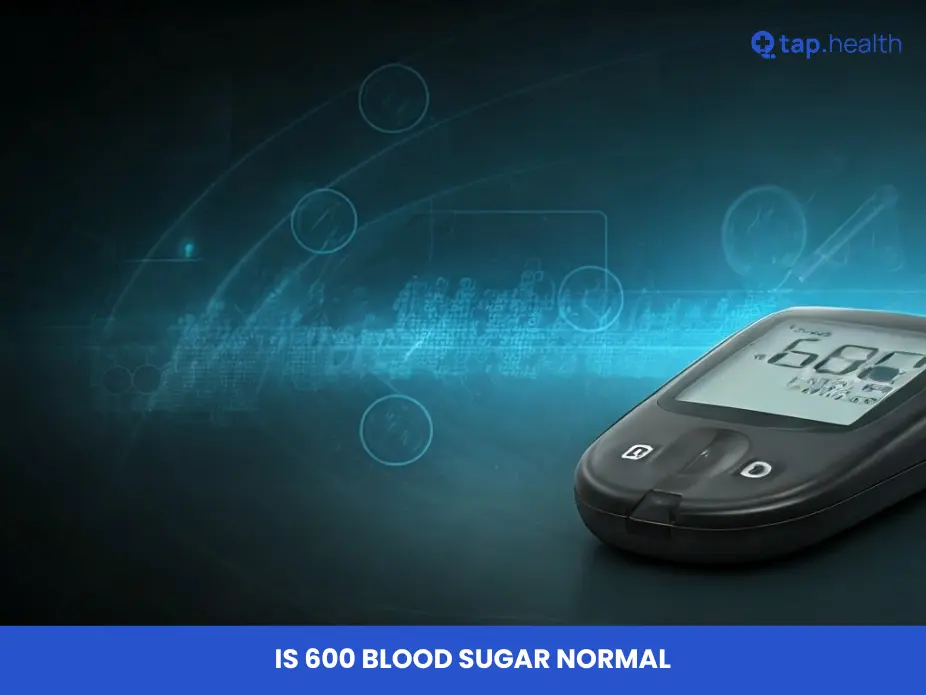Maintaining healthy blood sugar levels is essential for everyone, especially for individuals with diabetes. But what happens when your blood sugar spikes to 600 mg/dL? Is 600 blood sugar normal? In this comprehensive guide, we’ll delve deep into what blood sugar levels mean, the dangers of extremely high readings, and the steps you should take if you or someone you know experiences such high levels. Let’s keep it simple and straightforward to ensure everyone can understand the importance of this vital health metric.
What is Blood Sugar?
Blood sugar, or glucose, is the main source of energy for your body’s cells. It comes from the food you eat, particularly carbohydrates, and is transported through your bloodstream to be used by your cells for energy. The hormone insulin, produced by the pancreas, helps regulate blood sugar levels by allowing glucose to enter your cells.
Maintaining blood sugar within a normal range is crucial. Both high and low blood sugar levels can lead to serious health issues.
Understanding Blood Sugar Levels
Normal Blood Sugar Levels
Blood sugar levels are measured in milligrams per deciliter (mg/dL). According to the American Diabetes Association (ADA), the standard guidelines are:
- Fasting Blood Sugar (before meals): 70-99 mg/dL
- Postprandial Blood Sugar (after meals): Less than 140 mg/dL
- HbA1c (average over 3 months): Below 5.7%
Pre-diabetes and Diabetes
- Pre-diabetes: Fasting blood sugar between 100-125 mg/dL
- Diabetes: Fasting blood sugar of 126 mg/dL or higher on two separate tests
Hyperglycemia: What It Means
Hyperglycemia refers to high blood sugar levels. Chronic hyperglycemia is a hallmark of diabetes and can lead to various complications if not managed properly.
Is a Blood Sugar Level of 600 Normal?
No, a blood sugar level of **600 mg/dL is not normal. Such an extreme level indicates a severe hyperglycemic state that requires immediate medical attention. Normal blood sugar levels are significantly lower, and 600 mg/dL is well beyond what is considered safe.
Is a 600 Blood Sugar Level Dangerous?
Absolutely. A blood sugar level of 600 mg/dL is very dangerous and can lead to life-threatening conditions if not addressed promptly. It’s crucial to understand the risks associated with such high levels and take necessary actions to bring them down.
The Significance of a 600 Blood Sugar Reading
Immediate Risks of Blood Sugar Levels Around 600
When blood sugar levels reach 600 mg/dL, your body may struggle to function correctly. Immediate risks include:
- Diabetic Ketoacidosis (DKA): A condition where the body starts breaking down fats for energy due to insufficient insulin, leading to the accumulation of ketones and resulting in acidosis.
- Hyperosmolar Hyperglycemic State (HHS): More common in Type 2 diabetes, characterized by very high blood sugar levels without significant ketone production, leading to extreme dehydration and potential seizures or coma.
- Severe Dehydration: Excess sugar causes your kidneys to work harder to eliminate it, leading to dehydration.
- Organ Damage: High blood sugar can damage organs like the kidneys, heart, and eyes.
Long-Term Health Implications
Consistently high blood sugar levels can cause long-term damage, such as:
- Cardiovascular Disease: Increased risk of heart attacks and strokes.
- Neuropathy: Nerve damage that can lead to pain or loss of sensation, especially in the extremities.
- Nephropathy: Kidney damage that can lead to kidney failure.
- Retinopathy: Eye damage that can result in vision loss.
- Foot Complications: Poor circulation can lead to infections and amputations.
Health implications of a 600 blood sugar level
Experiencing a blood sugar level of 600 mg/dL can cause serious health issues. The body struggles to use glucose for energy at this level. This can lead to dangerous conditions like diabetic ketoacidosis (DKA) or a hyperosmolar hyperglycemic state (HHS). Common symptoms include needing to drink a lot, going to the bathroom often, blurred vision, feeling sick, tiredness, and confusion. If not treated, it could lead to a diabetic coma and require emergency treatment.
How the body reacts to extremely high blood sugar
When blood sugar levels get very high, like 600 mg/dL, the body tries to fight back. However, these defenses can get overwhelmed. This leads to the symptoms of high blood sugar.
Too much glucose in the blood affects how organs work, especially the kidneys. Severe high blood sugar can harm the immune system. This makes a person more open to infections. The body also tries to get rid of the extra sugar by urinating, which can cause dehydration.
Symptoms to Watch For at High Blood Sugar Levels
Recognizing Hyperglycemia Symptoms
High blood sugar can present various symptoms, including:
- Frequent Urination: Your body tries to eliminate excess sugar through urine.
- Extreme Thirst: Dehydration from frequent urination leads to intense thirst.
- Fatigue: Lack of glucose in cells results in persistent tiredness.
- Blurred Vision: High glucose levels affect the lenses in your eyes.
- Headaches: Dehydration and high sugar levels can cause headaches.
- Nausea and Vomiting: Can indicate diabetic ketoacidosis (DKA).
- Shortness of Breath: May signal respiratory distress.
- Confusion or Difficulty Concentrating: High sugar levels can impair cognitive functions.
When to Seek Medical Attention
If you experience any of the following, seek medical help immediately:
- Severe Thirst and Frequent Urination
- Nausea and Vomiting
- Shortness of Breath
- Confusion or Difficulty Breathing
- Unconsciousness
Delaying medical help can lead to serious complications.
Managing and Reducing High Blood Sugar
Lifestyle Changes for Better Blood Sugar Control
Making certain lifestyle adjustments can help manage and reduce high blood sugar levels:
- Balanced Diet: Focus on vegetables, lean proteins, and whole grains. Limit sugary and refined carbohydrates.
- Regular Exercise: Physical activity helps your body use insulin more effectively.
- Stress Management: Techniques like meditation, yoga, or deep breathing can reduce stress-related blood sugar spikes.
- Adequate Hydration: Drinking water helps your kidneys eliminate excess sugar.
Medical Interventions for Critical Levels
When blood sugar levels are dangerously high, medical intervention is necessary:
- Insulin Therapy: Administering insulin can help lower blood sugar levels quickly.
- Medications: Oral or injectable medications may be prescribed to manage blood sugar.
- Hospitalization: In severe cases, hospitalization might be required to stabilize your condition.
How Bad is a 600 Blood Sugar Level?
A blood sugar level of 600 mg/dL is extremely bad and poses significant health risks. It indicates that your body is not effectively managing glucose, which can lead to both immediate and long-term health complications if not addressed promptly.
Lifestyle Changes to Manage a Blood Sugar Level of 600
Yes, several lifestyle changes can help manage high blood sugar levels:
- Healthy Eating: Choose low-glycemic index foods that don’t spike blood sugar.
- Regular Physical Activity: Exercise helps your body use insulin more efficiently.
- Weight Management: Maintaining a healthy weight can improve insulin sensitivity.
- Limit Alcohol and Quit Smoking: Both can negatively affect blood sugar control.
Long-Term Effects of Consistently High Blood Sugar
Consistently high blood sugar can lead to:
- Heart Disease: Increased risk of heart attacks and strokes.
- Kidney Damage: Potential progression to kidney failure.
- Nerve Damage: Leading to numbness or pain, especially in the extremities.
- Vision Problems: Increased risk of retinopathy and vision loss.
- Foot Complications: Poor circulation can lead to infections and amputations.
How to Lower a Blood Sugar Level of 600
Lowering a blood sugar level of 600 mg/dL involves immediate and long-term strategies:
- Take Insulin or Medication: Follow your healthcare provider’s instructions.
- Stay Hydrated: Drink water to help your kidneys eliminate excess sugar.
- Exercise: Physical activity can help lower blood sugar levels.
- Monitor Blood Sugar: Keep track of your levels to ensure they are decreasing.
How to Treat a Blood Sugar Level of 600
Treating a blood sugar level of 600 mg/dL requires:
- Immediate Medical Attention: Contact your healthcare provider or go to the emergency room.
- Insulin Administration: May be necessary to bring levels down quickly.
- Hydration Therapy: Intravenous fluids might be needed to combat dehydration.
- Electrolyte Management: Ensuring your body’s electrolytes are balanced is crucial.
What to Eat If Your Blood Sugar is 600
If your blood sugar is high, focus on:
- Low-Carb Vegetables: Such as leafy greens, broccoli, and peppers.
- Lean Proteins: Like chicken, fish, or tofu.
- Healthy Fats: Including avocados, nuts, and olive oil.
- Fiber-Rich Foods: Helps slow down glucose absorption.
Avoid sugary foods, refined carbs, and beverages that can further spike your blood sugar.
When to Seek Medical Attention for a Blood Sugar Level of 600
Seek medical attention immediately if you have a blood sugar level of 600 mg/dL, especially if you experience symptoms like:
- Severe Thirst and Frequent Urination
- Nausea and Vomiting
- Confusion or Difficulty Breathing
- Unconsciousness
Delaying medical help can lead to serious complications.
Expert Opinions
Healthcare professionals emphasize the importance of maintaining blood sugar levels within the recommended range to prevent complications. Dr. Jane Smith, an endocrinologist at Mayo Clinic, states, “A blood sugar level of 600 mg/dL is a medical emergency. Immediate action is necessary to prevent severe health consequences.”
FAQ: Is 600 Blood Sugar Normal?
1.Is Blood Sugar of 600 Dangerous?
Yes, a blood sugar level of 600 mg/dL is dangerous and requires immediate medical attention to prevent complications.
2.What Happens If the Sugar Level is 600?
At 600 mg/dL, your body struggles to manage glucose, leading to symptoms like extreme thirst, frequent urination, fatigue, and potential severe complications like diabetic ketoacidosis.
3.How Do You Treat Blood Sugar of 600?
Treatment involves immediate medical intervention, including insulin administration, hydration, and possibly hospitalization to stabilize blood sugar levels.
4.What Are Healthy Blood Sugar Levels?
Healthy blood sugar levels are:
- Fasting: 70-99 mg/dL
- Postprandial: Less than 140 mg/dL
- HbA1c: Below 5.7%
5.At What Point Should Medical Attention Be Sought for a Blood Sugar Level of 600?
Immediate medical attention is necessary when blood sugar reaches 600 mg/dL, particularly if accompanied by severe symptoms.
6.Are There Any Lifestyle Changes That Can Help Manage a Blood Sugar Level of 600?
Yes, adopting a balanced diet, regular exercise, stress management, and proper medication adherence can help manage high blood sugar levels.
7.What Are the Long-Term Effects of Consistently Having a Blood Sugar Level of 600?
Long-term effects include increased risk of heart disease, kidney damage, nerve damage, vision problems, and foot complications.
8.How Do You Lower a Blood Sugar of 600?
Lowering a blood sugar level of 600 mg/dL involves taking insulin or prescribed medications, staying hydrated, exercising, and monitoring your levels closely.
9.My Sugar Level is 600 After Meal
If your blood sugar is 600 mg/dL after a meal, it’s essential to follow your healthcare provider’s instructions, which may include taking insulin and seeking medical advice.
10.My Blood Sugar is Over 600 What Should I Do
If your blood sugar exceeds 600 mg/dL, take your prescribed insulin or medications, drink water, and contact your healthcare provider immediately.
11.Is Blood Sugar Level of 700 Dangerous
Yes, a blood sugar level of 700 mg/dL is extremely dangerous and requires urgent medical attention to prevent life-threatening complications.
12.How to Reduce Blood Sugar Level Immediately
To reduce blood sugar levels immediately:
- Take Prescribed Insulin or Medications
- Drink Water to Stay Hydrated
- Engage in Light Exercise if Safe
- Avoid Sugary Foods and Drinks
13.Normal Blood Sugar Levels Chart
| Condition | Fasting (mg/dL) | Postprandial (mg/dL) | HbA1c (%) |
|---|---|---|---|
| Normal | 70-99 | <140 | <5.7 |
| Pre-diabetes | 100-125 | 140-199 | 5.7-6.4 |
| Diabetes | ≥126 | ≥200 | ≥6.5 |
| Severe Hyperglycemia | ≥300 | N/A | N/A |
14.What Level of Blood Sugar is Dangerous?
Blood sugar levels consistently above 180 mg/dL after meals or above 130 mg/dL fasting are considered high and can be dangerous if not managed.
15.What Level of Blood Sugar is Dangerous for Type 2 Diabetes
For individuals with Type 2 diabetes, blood sugar levels above 180 mg/dL after meals and above 130 mg/dL fasting are considered dangerous and require attention.
16.What Foods Lower Blood Sugar Immediately
Foods that can help lower blood sugar quickly include:
- Leafy Greens: Such as spinach and kale.
- Lean Proteins: Like chicken and fish.
- Whole Grains: Such as brown rice and quinoa.
- Healthy Fats: Including avocado and nuts.
17.How Bad is a 600 Blood Sugar Level
A blood sugar level of 600 mg/dL is very bad and poses serious health risks, including potential organ damage and life-threatening conditions like diabetic ketoacidosis.
18.Is 600 Diabetes High
Yes, a blood sugar level of 600 mg/dL is considered very high for individuals with diabetes and requires immediate medical attention.
19.Blood Sugar Level 600 is Normal
No, a blood sugar level of 600 mg/dL is not normal. It indicates severe hyperglycemia and requires urgent medical care.
20.What Happens If the Sugar Level is 600?
A sugar level of 600 mg/dL can lead to symptoms like extreme thirst, frequent urination, fatigue, and can escalate to diabetic ketoacidosis if not treated promptly.
21.How Do You Treat Blood Sugar of 600?
Treating a blood sugar level of 600 mg/dL involves:
- Immediate Insulin or Medication Administration
- Hydration with Water or Electrolyte Solutions
- Monitoring Blood Sugar Levels Frequently
- Seeking Medical Help
Conclusion
A blood sugar level of **600 mg/dL is not normal and poses significant health risks. Understanding the signs, symptoms, and necessary actions can help you manage and prevent such dangerous spikes. Always work closely with your healthcare provider to maintain your blood sugar within a healthy range and seek immediate medical attention if you experience extremely high levels. Remember, your health is paramount, and timely intervention can save lives.



